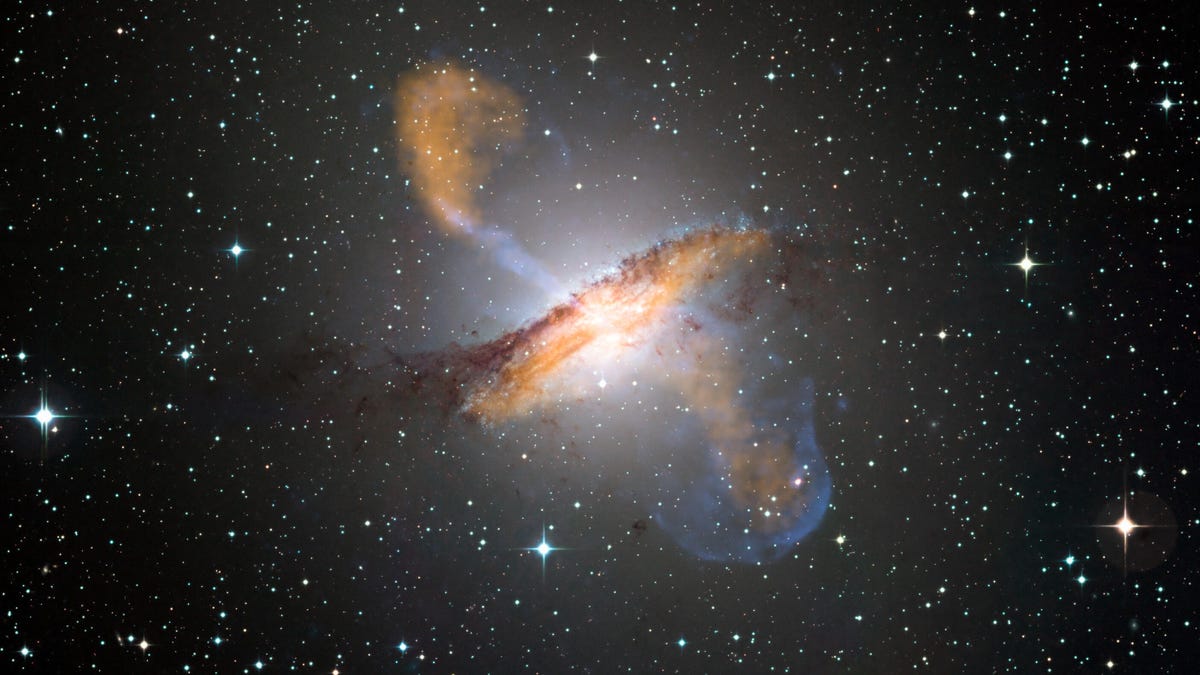After capturing first photo of a black hole, Event Horizon Telescope zooms in on a second
From the telescope that brought you hits like The First Black Hole Photo comes the best look yet at extreme cosmic jets.

Are all black holes functioning the same, regardless of size?
We tend to think of black holes as gargantuan, light-eating behemoths. But even supermassive black holes, the gravitational sinkholes that exist at the center of galaxies, come in an array of sizes. Take M87*, which lies at the center of the Messier 87 galaxy. It's about 6 billion times more massive than our sun. Or you could look at Sgr A*, which lies at the center of the Milky Way and is only (only!) 4 million times more massive than the sun. Small, as far as supermassive black holes go.
The incredible size of M87* was partly why it was such a good candidate for the Event Horizon Telescope to capture the world's first image of a black hole. That feat, achieved in 2017, was immediately hailed as a breakthrough in astrophysics when it was revealed to the world in 2019. The portrait was the crowning achievement of years of work using a handful of observatories around the world that essentially functioned as one, planet-size telescope. The breakthrough allowed scientists to see the shadow cast by Messier 87's dark heart.
But that was just the beginning.
Astrophysicists weren't going to stop at just one black hole. They then turned their attention toward another supermassive black hole, about 100 times smaller than M87*, lying at the center of the nearby galaxy known as Centaurus A. Using the same technique that captured M87*, astrophysicists have now been able to image a powerful jet of matter blasting away from Centaurus A's black hole in ultra-high resolution, revealing more about how these perplexing phenomena emerge.
The details were published in the journal Nature Astronomy on Monday.
"The primary goal of the EHT is to image black holes," says Michael Janssen, an astrophysicist at the Max Planck Institute for Radio Astronomy in Bonn, Germany, and lead author on the study. "But jets are naturally launched by the black holes that we are studying. So, in order to fully understand black holes, we also need to understand these jets and how they are produced."
Cosmic jets are produced by many black holes -- including M87* -- and are essentially runaway freight trains of plasma hurled from a rapidly spinning black hole's accretion disk.
Until now, the highest resolution image of Centaurus A's jet came from the Tanami array (first panel). The EHT was able to zoom in 16 times closer than Tanami to produce the image in the middle panel of its plasma jet. The third panel is the plasma jet observed in the Messier 87 galaxy.
"These narrow, focused beams of plasma carry away energy from small scales close to the black hole (whose size is less than that of our solar system) and deposit them into the surrounding environment on much larger scales," says James Miller-Jones, an astrophysicist at Curtin University in Australia and member of the International Centre for Radio Astronomy Research (ICRAR). Jets, Miller-Jones says, can affect the evolution of the galaxy and the galaxy cluster -- so astronomers are keen to understand them better.
Janssen and colleagues are one such group of astronomers. They wanted to zoom in on the jets to see how they function close to the black hole. The EHT made it possible.
The EHT consists of eight observatories from across the world and uses a technique known as Very Long Baseline Interferometry, or VLBI. Generally, Janssen notes, bigger telescopes provide sharper images -- but there's only so big you can build them. Instead of making one monolithic telescope, the EHT links telescopes from around the world virtually, providing a resolution equivalent to a single telescope "thousands of kilometers in size."
With it, the team could focus in on the jet in Centaurus A and see it more sharply than ever before. It also allowed them to image the jet extremely close to the black hole.
"We are able to study this jet with a sub-light-day resolution, which has never been achieved before," Janssen says. The EHT observations allow the team to see about 0.6 light-days away from the black hole -- which sounds tiny but it equivalent to about 2.5 times the distance between the sun and Pluto, a lazy 9.6 billion miles.
Peering into Centaurus A's heart and comparing their observations with theoretical models, the team find the black hole's jet has brightened edges and looks strikingly similar to the one created by M87*. That's critical because it brings us back to our opening question: Are all black holes functioning the same, regardless of size?
The Centaurus A jet suggests this could be the case. That is important for two reasons: it's consistent with Albert Einstein's theory of General Relativity, and it is "vindication that the fundamental properties of jets depend are dependent on the mass of the black hole that launches them," Miller-Jones says.
He adds that this scaling might then hold for much, much smaller black holes, with masses only 10 to 100 times that of the sun. We can't prove these little black holes because they are too small -- but by studying their monstrous cousins, we're unlocking some of the mysteries of the universe's most enigmatic giants.

